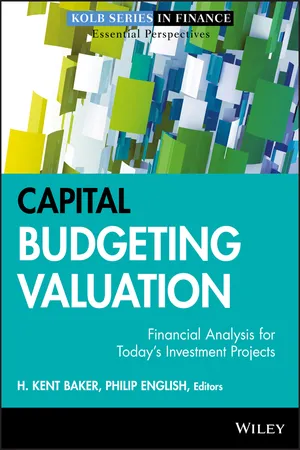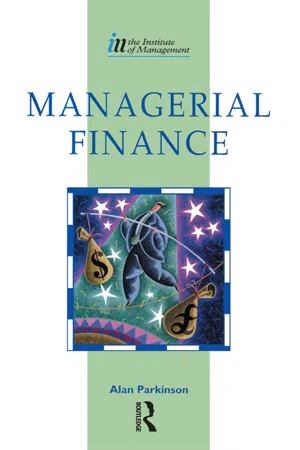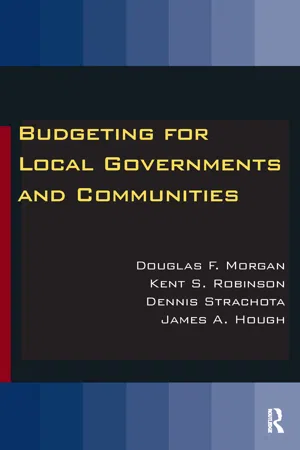Capital Budget
A capital budget refers to the allocation of funds for long-term investment in assets such as property, equipment, or infrastructure. It involves evaluating potential projects, estimating their costs and benefits, and making decisions about which investments to pursue. Capital budgeting helps businesses plan for and manage their long-term financial commitments and growth opportunities.
7 Key excerpts on "Capital Budget"
- eBook - ePub
Capital Budgeting Valuation
Financial Analysis for Today's Investment Projects
- H. Kent Baker, Philip English, H. Kent Baker, Philip English(Authors)
- 2011(Publication Date)
- Wiley(Publisher)
...Chapter 1 Capital Budgeting: An Overview H. KENT BAKER University Professor of Finance and Kogod Research Professor, Kogod School of Business, American University PHILIP ENGLISH Assistant Professor of Finance, Kogod School of Business, American University INTRODUCTION Capital Budgeting refers to the process that managers use to make decisions about whether long-term investments or capital expenditures are worth pursuing by their organizations. In other words, Capital Budgeting is the process of planning, analyzing, selecting, and managing capital investments. The basic notion is that managers use the capital, usually long-term funds, raised by their firms to invest in assets (also called capital goods) that will enable the firm to generate cash flows for at least several years into the future. Typical investments include replacements of existing assets and expansion of existing or new product lines. Capital Budgeting is one of the most challenging tasks facing management because it concerns the investment decision, which deals with allocating funds over time in order to achieve a firm's objectives. For most companies, the investment decision has a greater impact on value than does the financing decision, which deals with acquiring needed funds. However, both investment and financing decisions are intertwined and at the heart of financial management. Capital Budgeting has a long-term focus that provides a link to an organization's strategic plan, which specifies how an organization expects to accomplish long-term strategic goals. Many capital investments require a substantial commitment of a firm's resources that directly affect firm performance, competitive position, and future direction. Because capital investments often commit a large amount of funds for lengthy periods, they are not only difficult or costly to reverse but also difficult to convert to more liquid assets (Migliore and McCracken, 2001)...
- eBook - ePub
- Alan Parkinson(Author)
- 2012(Publication Date)
- Routledge(Publisher)
...A common feature that all Capital Budgeting decisions have with shorter term investments is that managers are looking at making investments which will (hopefully!) produce returns. The distinction is that the longer term investment decision will produce returns over a number of future time periods rather than the current period returns which arise from other types of decisions. Capital investment decisions will generally be concerned with the planning for and management of activities such as: the acquisition of fixed assets such as land and buildings, plant and equipment and vehicles (be it a first-time or replacement acquisition) investment in a special project such as a marketing/advertising campaign or research and development the expansion of current facilities, be they production or administrative or in relation to any other entry into new product/service provision investment in development of managers, such as yourself, through training and education. Such investment decisions are never easy Often, given the long-term nature of the decision consequences, the projected outcomes and associated returns are at best uncertain and at worst unpredictable and/ or intangible. Given this scenario it is understandable that many managers seek advice from all quarters as an aid to reducing the risk of making the wrong capital investment decisions. What they invariably seek is a framework, at least from a financial angle. A framework for predicting the future If you as a manager had the opportunity to design an appropriate advisory framework from scratch, it is likely that you would wish the design to help you to solve certain key problems which might hamper your effective decision-making...
- eBook - ePub
Hospitality Finance and Accounting
Essential Theory and Practice
- Rob Ginneken, Rob van Ginneken(Authors)
- 2019(Publication Date)
- Routledge(Publisher)
...Chapter 5 Capital Budgeting Planning for long-term asset expenditure Learning outcomes At the end of this chapter, readers should: understand the importance of ongoing capital investment in hospitality firms; differentiate between the accounting treatment of capital investment and repair and maintenance expenditure; understand the notion of the time value of money; be able to apply investment appraisal techniques. Theory James W. Hesford Michael J. Turner Introduction The purpose of this chapter is to give you the knowledge and tools to evaluate long-term capital investments. In addition to day-to-day operational decision-making, hospitality managers also engage in planning. They develop short- and long-term budgets, and frequently make decisions and/or recommendations for long-term capital investments. Capital Budgeting is the term used to describe the process of developing budgets for capital investment. Long-term capital investments establish a firm’s capabilities and frequently define the identity of a firm. The firm’s survival depends on the firm making the right decisions. Capital investments require large cash outlays and have a long-term impact on future profitability. Undertaking a “bad” project could lead to bankruptcy, whereas not undertaking a “good” project could make the firm less competitive, also threatening its long-term viability. Accordingly, hospitality managers must effectively plan for long-term capital investment. In every hospitality organisation there is an ongoing need to replace assets, assets that include furniture, fixtures and equipment (FF&E). Further, hospitality firms operate in highly uncertain and competitive environments, with demand fluctuating due to the economy, terrorist events, natural disasters and customers’ preferences. Competing in this environment, managers must think strategically about capital investment. For example, given a limited amount of funding, should the hotel expand by acquiring additional assets (e.g...
- eBook - ePub
- Cloete M, Marimuthu F(Authors)
- 2019(Publication Date)
- Van Schaik Publishers(Publisher)
...327 18 Capital Budgeting Outcomes At the end of this chapter, students should be able to describe the Capital Budgeting process explain the purpose of investment appraisal identify a project’s relevant cash flows analyse an investment project’s costs, benefits and risks calculate a project’s payback period, net present value, internal rate of return evaluate investment projects. Chapter outline 18.1 Introduction 18.2 Capital Budgeting process 18.3 Categories of Capital Budgeting projects 18.4 Why do organisations use investment appraisal? 18.5 Relevant and irrelevant cash flows in investment appraisal 18.6 Capital Budgeting techniques 18.6.1 Payback method 18.6.2 Accounting rate of return 18.6.3 Net present value 18.6.4 Profitability index 18.6.5 Internal rate of return 18.1 Introduction Organisations need to make important decisions regarding which long-term projects (fixed assets such as property, plant and equipment) they should undertake that will generate returns, and which they should reject. To arrive at such decisions, organisations use the Capital Budgeting process. A profit-making organisation will have to provide appropriate returns to those who have invested their money in it. To achieve that, the organisation will have to identify projects that are suitable and that can provide the organisation itself with such appropriate returns. The Capital Budgeting process involves maximisation of shareholder wealth. Therefore, in striving to maximise the wealth of shareholders, an organisation must bear in mind the needs of stakeholders other than shareholders, such as suppliers, employees, and the general public. 328 18.2 Capital Budgeting process Capital decisions are very costly, and therefore mistakes will involve very high costs if they are to be reversed. It is very important to plan well for capital investments...
- eBook - ePub
The Power of Accounting
What the Numbers Mean and How to Use Them
- Lawrence Lewis(Author)
- 2012(Publication Date)
- Routledge(Publisher)
...This is true, but such a statement could lead one to the conclusion that there is only a short run and a long run and nothing in between. In reality, the budgeting process encompasses a continuum, as Figure 5.1 illustrates. Figure 5.1 Capital Budgeting Decisions Decisions relating to capital expenditures are not easily reversible. They generally involve large sums of money and long periods of time. So a poor decision of this sort is going to cost a lot of money and it is a decision you are going to have to live with for a long time. Not surprisingly, these are often thought to be among the most important decisions an organization can make. More than one organization has declared bankruptcy solely because someone or some committee made a poor Capital Budgeting decision. Take a trip through your local industrial district and note the shuttered factories and warehouses. In how many cases had someone miscalculated their firm’s future cash flows? Short-term decisions relate more to day-to-day operations, while Capital Budgeting involves strategic decisions that affect long-term goals. Capital Budgeting decisions may include decisions to buy or not to buy major pieces of equipment, to buy equipment from one manufacturer instead of another, to buy one machine versus a similar one, to introduce or not introduce a new product line, to expand overseas, to build a new plant and so on. Both short-term and long-term decisions should utilize incremental analysis. In our discussion in the previous chapter we stressed that when making short-term decisions we want to rely only on relevant information. And we defined relevant information as “expected future information that varies amongst alternatives.” The same approach and the same rules apply equally to long-term decisions...
- eBook - ePub
- Debi J Peverill(Author)
- 2018(Publication Date)
- Painless Financial Training Group Inc.(Publisher)
...Chapter 19. Capital Budgeting What is the difference between Capital Budgeting and regular budgeting? Capital Budgeting refers to the purchase of fixed assets such as equipment, vehicles, land, and buildings. This is the type of purchase that shows up on a balance sheet not on the income statements. Capital Budgeting is a little more complicated because it ends up affecting the income statement only through depreciation. Remember the discussion about assets—they are things you pay for that last for longer than a year and generally cost more than $500. Because these items last longer than a year, we attempt to spread the cost over a number of time periods. We do this through depreciation, which has already been discussed in this book. The regular kind of budgeting is actually called operational budgeting by stuck-up accountants everywhere. Most business owners do operational budgeting because it is the type of budgeting that helps you determine whether you need to increase sales or reduce expenditures. Capital Budgeting on the other hand is about deciding which capital items the business should purchase. This is an area where we often just do some math in our heads and then decide. Or it is an area where we do not make a financial decision. The decision about buying a car often has nothing to do with the financial aspects. We buy a car that we think is an expression of our personality or that will affect other people’s perception of us. Even though an older car may in fact work just as well as a new car, we are under the impression that if we buy a new car, people will think that we are doing better and they will be more likely to think we are successful and therefore should give us their business. We are going to talk about a couple of different methods used to make decisions...
- eBook - ePub
- Douglas Morgan, Kent S. Robinson, Dennis Strachota, James A. Hough(Authors)
- 2017(Publication Date)
- Routledge(Publisher)
...First, competition for resources is intense for both capital and operating needs, especially during economic downturns. Because raising revenue is subject to political inhibition and legal constraints such as tax limitations, it’s likely that spending needs will greatly outstrip available resources, whether for operating or capital purposes. Second, special interests, typically singularly focused, can greatly influence budget decisions. On the capital side, those groups will frequently favor a particular project and then press the governing body to allocate funding for that purpose. For example, neighborhood organizations usually spearhead efforts to secure funding for street improvements and parks in their respective neighborhoods. Third, due to limited resources and the influence of special groups, efforts are made on both the operating and Capital Budget sides to rationalize spending decisions. Some sort of priority-setting or ranking process is commonly used to sort out those decisions initially. Because Capital Budgets are the culmination of multiyear planning, the process followed by many jurisdictions can be more extensive and methodical than the process used for the operating budget. Although not practiced by every jurisdiction, the following steps typically comprise the capital improvement planning and budgeting process: setting Capital Budget and finance policies; inventorying existing capital assets; identifying capital project needs; determining capital financing options and potential; and making a capital plan and budget decisions. Nonprofit organizations also engage in capital projects, as discussed in Exhibit 16.1, but not nearly to the extent that public entities, responsible for critical infrastructure, do. That does not mean, however, that capital projects for nonprofits do not require a significant investment of financial resources. Capital Budget Policies A jurisdiction’s financial management policies typically include Capital Budgeting policies...






